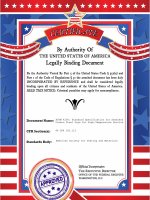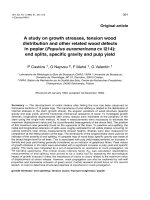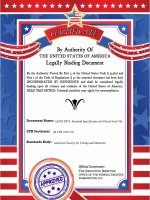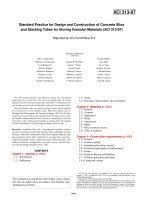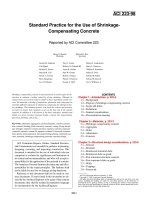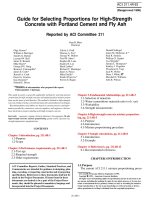standard specification for bonding hardened concrete, steel, wood, brick, and other amaterials
Bạn đang xem bản rút gọn của tài liệu. Xem và tải ngay bản đầy đủ của tài liệu tại đây (56.99 KB, 5 trang )
Standard Specification for Bonding Hardened
Concrete, Steel, Wood, Brick, and Other
Materials to Hardened Concrete with a
Multi-Component EpoxyAdhesive
(AC1 503.1-92, reapproved 1997)*
R.W. Gaul
George Selden
Chairman
Secretary
Russell H. Brink
George
Horeczko
Harold C.
Klassen
Joseph A. McElroy
Leonard J. Mitchell
Myles A. Murray
Leonard Pepper
G.M. Scales
Raymond J. Schutz
George W. Whitesides
Reported by ACI
Committee 503
Committee voting on the 1992 revisions:
Raymond J. Schutz
Chairman
Milton D. Anderson
David P. Hu
Myles A. Murray
Secretary
Richard
Montani
Roger W. Black
John P. Cook
Floyd E.
Dimmick
Wolfgang D.
Eisenhut
Jack J. Fontana
Robert W. Gaul
Paul R. Hollenbach
T.
Michael
Jackson
Troy D. Madeley
Albert
Mayer
Joseph A. McElroy
Paul F.
McHale
Pctcr
Mendis
Joseph M. Plecnik
Hamid
Saadatmanesh
W. Glenn Smoak
Joe Solomon
Michael M. Sprinkel
Douglas G.
Walters
This
specification
describes
the work
of
bonding
hardened concrete.
steel,
wood,
brick
and other
materials
to hardened
concrete
with
a
multi-com-
ponent epoxy
adhesive
such as defined for this purpose in ASTM C 881.
It includes
controls
for adhesive labeling,
storage,
handling,
mixing
and
application, surface evaluation and preparation as well as inspection
and
quality control.
Keywords:
adhesives; aluminum; bond (concrete to
concrete);
bonding;
bricks; concrete construction; copper;
epoxy
resins;
hardened
concrete:
quality control; safety: specifications;
standards;
steels; wood.
FOREWORD
This
foreword is included for explanatory purposes
only;
it
does not form
a
part of Standard Specification ACI 503.1.
This specification is
a
reference standard which the
Architect/Engineer
may
cite
in
the project specifications,
together with the
supplemental
requirements for the
specific
project.
It is written in terse,
imperative
language
and is
ACI
Committee Reports, Guides, Standard Practices, and
Commentaries are intended for guidance in designing, plan-
ning, executing, or inspecting construction and in preparing
specifications. References to these documents shall not be
made in the Project Documents. If items found in these
documents are desired to be a part of the Project Doc-
uments, they should be phrased in mandatory language and
incorporated into the Project Documents.
divided
into two sections: general requirements and materi-
als and applications,
including a section on the
all-
important
surface
preparation.
This
document
covers
materials and methods for bond-
ing concrete, steel, wood, brick, aluminum, copper, and
other materials to hardened concrete.
This
specification is written in the section and three-part
format of the Construction
Specifications
Institute, but with
the numbering system modified to
ACI
requirements.
A specification guide and
checklist
are included as a
preface to, but not forming
a
part of, Standard Specification
ACI 503.1.
The
purpose of this guide and checklist
is
to
assist
the
Architect/Engineers'
designer(s) and specifier(s) to
properly
choose and
specify,
the necessary supplemental
requirements
for the project specifications.
’
Adopted`
as
a standard of t
he
American
Concrete Institute
effective
June 1979,
in accordance with
the
Institute’s standardization procedure.
It
was revised
according
to
the
expedited
procedure effective October 1986 and March 1992.
Copyright
1978
and 1986 American Concrctc Institute.
All
rights
reserved
including rights of reproduction and use in any
form
or by
any means. including
the
making of copies by
any
photo process. or by any
elec-
tronic
or mechanical device.
printed
or written
or
oral,
or recording for sound or
visual
reproduction or for use in any knowledge or
retrieval
system or device.
unless
permission in
writing
is obtained from the copyright proprietors.
503.1-l
(Reapproved 1997,2003)
503.1-2 ACI STANDARD
CONTENTS
Specification guide, pg. 503.1-2
Specification checklist, pg. 503.1-3
Section
1-General
requirements, pg. 503.1-3
1
.1-Scope
1.2-Notation
1.3-Specification wording
1.4-Reference
standards
Section 2-Materials
and
application, pg. 503.1-4
Part
2.1-General,
pg. 503.1-4
2.1.1-Description
2.1.2-Submittals
2.1.3-Quality
assurance
2.1.4-Product
delivery, storage, and handling
2.1.5-Project
conditions
Part
2.2-Products,
pg.
503.1-4
2.2.
1-Epoxy
adhesive
Part
2.3-Execution,
pg. 503.1-4
2.3.1-Preparation
of concrete surfaces
2.3.2-Preparation
of carbon steel surfaces
2.3.3-Preparation
of galvanized steel surfaces
2.3.4-Preparation
of aluminum surfaces
2.3.5-Preparation
of copper and copper-alloy
surfaces
2.3.6-Preparation
of wood surfaces
2.3.7-Inspection
of concrete surfaces prior to
adhesive application
2.3.8-Adhesive mixes
2.3.9-Adhesive
application and placing of
elements to be bonded
2.3.10-Cleanup
2.3.11-Safety
SPECIFICATION
GUIDE
SGl-Standard
Specification ACI 503.1 is intended to
be used essentially in its entirety, by citation in the
project specification, to cover all usual requirements for
bonding hardened concrete, steel, wood, brick, and other
materials to hardened concrete with a multi-component
epoxy adhesive. Individual sections, parts, or articles
should not be copied into project specifications since
taking them out of context may change their meaning’s_
SG2-However,
adjustments to the needs of a parti-
cular project shall be made by the Architect/Engineer’s
designers and specifiers by reviewing each of the items
indicated in this specification guide and checklist and
then including their decisions on each as mandatory re-
quirements in the project specification.
SG3-These mandatory requirements shall designate
specific qualities, procedures, materials, and performance
criteria for which alternatives are permitted or for which
provision is not made in Standard Specification
ACI
503.1. Or exceptions shall be taken to Standard Spe-
cification
ACI
503.1 if required.
SG4
-
A
statement such as the following will serve to
make Standard Specification
ACI
503.1 an official part of
the contract requirements:
The use of an epoxy adhesive for bonding hardened
concrete, steel, wood, brick, and other materials to
hardened concrete shall conform to all requirements
of “Standard Specification for Bonding Hardened
Concrete, Steel, Wood, Brick, and Other Materials to
Hardened Concrete with a Multi-Component Epoxy
Adhesive
(ACI
503.1),”
published by the American
Concrete Institute, Detroit,
Mich.,
except as modified
by the requirements of this project specification.
SG5-The
specification checklist that follows is ad-
dressed to each item of
ACI
503.1 that requires the
designer/specifier to make a choice where alternates are
indicated, or to add provisions where they are not in-
dicated in
ACI
503.1, or to take exceptions to
ACI
503.1.
The checklist consists of section, part, and article heads
of
ACI
503.1, and accompanying notes to the designers/
specifiers to indicate the action required of them.
EPOXY RESINS
SPECIFICATION CHECKLIST
503.1-3
1.1
1.4
Part
Section/Part/Article
of
ACI
503.1
Notes to the Designer/Specifier
Section l-General requirements
Scope
Reference standards
Section 2-Materials and applications
2.1-General
2.1.2 Submittals
2.1.3.2 Application control
2.1.5 Project conditions
Part
2.2-Products
2.2.1 Epoxy adhesive
Part
2.3-Execution
2.3.1 Preparation of concrete surfaces
2.3.2 Preparation of carbon steel surfaces
2.3.6.2 Moisture content of wood
Indicate specific scope.
Review applicability of cited references and take ex-
ceptions if required.
To whom sent?
To whom sent?
Specify any which would specifically affect this work.
Specify Class and Grade as indicated.
Also
specify ad-
ditional performance requirements and/or approved
suppliers, as advisable.
Specify limitations, if any, on use of mechanical abra-
sion and
on disposal of waste products.
If sand abrasive not suitable, specify grit or shot.
A commercially available “probe” type moisture meter
should be used except for plywood which will require a
“flat plate” type with a depth of field suitable for
plywood.
For a durable adhesive bond to wood the wood
should be sealed on all exposed sides to reduce ab-
sorption of moisture which will swell the wood and
stress (to rupture) the wood fibers which are re-
strained by the cured adhesive.
SECTION l-GENERAL REQUIREMENTS
l.l-Scope
1.1.1
This standard specification covers the bonding of
hardened concrete, steel, wood, brick, and other ma-
terials to hardened concrete with a multi-component
epoxy adhesive.
1.1.2 The provisions of this standard specification shall
govern unless otherwise specified in the contract doc-
uments. In case of conflicting requirements, the contract
documents shall govern.
1.2-Notation
1.2.1 ACI:
American Concrete Institute
P.O. Box 19150
Detroit, MI 48219
1.2.2 ASTM:
American Society for Testing and
Materials
1916 Race Street
Philadelphia, PA 19103
1.2.3 SSPC:
Steel Structures Painting Council
4400 Fifth Avenue
Pittsburgh, PA 15213
1.3-Specification
wording
1.3.1 The
language of this standard specification is
generally imperative and terse, and may include incom-
plete sentences. Omissions of phrases and of words such
as “the contractor shall,” “in accordance with,” “shall be,”
“as indicated,” “a,” “an,” “the,” “all,” etc., are intentional.
Omitted phrases and words shall be supplied by infer-
ence.
1.4-Reference standards
1.4.1 The standards referred to
in
this Standard Spe-
cification
ACI
503.1 are listed in Articles 1.4.2 and 1.4.3
503.1-4 ACI STANDARD
of this section, with their complete designation and title
including the year of adoption or revision and are de-
clared to be a part of this Standard Specification
ACI
503.1 the same as if fully set forth herein, unless
otherwise indicated in the contract documents.
1.4.2
ASTM standard
C 881-87
Standard Specification for Epoxy-Resin-Base
Bonding Systems for Concrete
1.4.3
SSPC standards
Vis l-67T Surface Preparation Standard No.
1-Pic-
torial Surface Preparation. Standards for
Painting Steel Surfaces
SP1-63
Surface Preparation Specification No. 1,
Solvent Cleaning
SP2-63
Surface Preparation Specification No. 2,
Hand Tool Cleaning,
SP3-63
Surface Preparation Specification No. 3,
Power Tool Cleaning
SP6-63
Surface Preparation Specification No. 6,
Commercial Blast Cleaning
SECTION 2-MATERIALS AND APPLICATION
Part
2.1-General
2.1.1
Description
-This section covers the re-
quirements for surface preparation of specified materials
and for application of the multi-component epoxy
adhesive.
2.1.2
Submittals
2.1.2.1 Contractor shall submit manufacturer’s
certification verifying conformance to material spe-
cifications specified in Part 2.2.
2.13
Quality assurance
2.1.3.1
Labeling-Clearly
mark all containers with
the following information:
a) Name of manufacturer
b) Manufacturer’s product identification
c) Manufacturer’s instructions for mixing
d) Warning for handling and toxicity
2.1.3.2 Application
control-Submit
mixing and
application procedures for approval prior to
USC.
2.1.4 Product delivery, storage, and handling
2.1.4.1 Delivery of
materials-Deliver
all materials
in sealed containers with labels legible and intact.
2.1.4.2 Storage of materials-Store all materials at
temperatures between 40-100 F (S-38 C) unless otherwise
recommended by manufacturer.
2.1.4.3 Handling
of
materials-Handle all materials
in a safe manner and in a way to avoid breaking con-
tainer seals.
2.1.5 Project
conditions
2.1.5.1 Environmental requirements-Contractor
shall comply with manufacturer’s recommendations as to
environmental conditions under which the epoxy com-
pound may be applied.
Part
2.2-Products
2.2.1
E
poxy
adhesive-ASTM C 881 Type I for non-
load bearing or Type IV for load bearing applications.
Curing temperature requirements (Class) shall be deter-
mined by supplier and contractor after project conditions
have been established. Use Grade 2 (medium viscosity)
for bonding mating surfaces. Use Grade 3 (nonsagging)
for overhead, or vertical, or sloping, surfaces, and for
nonmating surfaces.
Part
2.3-Execution
2.3.1
Preparation of concrete surfaces
2.3.1.1 Concrete surfaces to which epoxies are to be
applied shall be newly exposed parent concrete free of
loose and unsound materials. Prepare surfaces by mech-
anical abrasion.
2.3.1.2
Mechanical
abrasion-Use sandblasting,
scarifying, waterblasting, or other approved means.
2.3.2 Preparation of carbon steel surfaces
2.3.2.1 Blast-clean carbon steel surfaces, using
SSPC
SP6,
to give a surface condition corresponding to
ASa2,
BSa2, CSa2 of SSPC Vis 1, depending on the ini-
tial surface condition of the steel surface. Use sand
abrasive.
2.3.2.2 Prior to blast-cleaning, clean surfaces with
SSPC SPl, SP2, and SP3, as required.
2.3.2.3 Remove blast-cleaning residue with com-
pressed air from an oil-and-water-free compressed air
source.
2.3.3
Preparation of galvanized steel
surfaces
2.3.3.1 Scrub galvanized steel surfaces thoroughly
in accordance with SSPC SPl, wash well with lime water,
and dry.
2.3.3.2 For galvanized steel surfaces showing signs
of subsurface corrosion, blast-clean as specified in Article
2.3.2 for carbon steel.
2.3.4 Preparation of aluminum
surfaces
23.4.1 Scrub aluminum surfaces thoroughly with a
nonchlorinated cleaner and then etch with proprietary
chromate treatment in strict compliance with manu-
facturer’s application instructions and safety warnings.
2.3.4.2 After etching, wash surface with distilled
water and
then
dry thoroughly.
2.3.5
Preparation
of copper and copper-alloy surfaces
2.3.5.1
Blast-clean copper and copper-alloy surfaces
as specified in Article 2.3.2 for carbon steel.
2.3.5.2 Where blast-cleaning is not practical, clean
the copper or copper-alloy surfaces with aqueous house-
hold ammonia, wash surfaces with distilled water, and
then
dry thoroughly.
2.3.6 Preparation of wood
surfaces
2.3.6.1 Clean wood surfaces of all visible loose or
foreign particles or contaminants by sanding. Remove
EPOXY RESINS
503.1-5
sanding or filling dust by wiping with an alcohol-soaked
rag, or clean with oil-and-water-free compressed air.
2.3.6.2 For use with moisture-sensitive epoxy
adhesives, reduce moisture content of wood to below 12
percent by weight, or the wood should appear dry to
touch.
2.3.7
Inspection of concrete surfaces prior to adhesive
application
2.3.7.1 Inspect all concrete surfaces prior to
application of adhesive to insure that requirements of
this Article
2.3.7
are met.
2.3.7.2 Surfaces
shall
be sound and have coarse
aggregate exposed. Coarse aggregate requirement may be
waived when preparation is in accordance with Article
2.3.1.3.
2.3.7.3 Surfaces shall be free of any deleterious
materials such as laitance, curing compounds, dust, dirt,
and oil. Materials resulting from surface preparation spe-
cified in Article 2.3.1 shall be removed.
2.3.7.4 All concrete surfaces shall be dry unless a
water-insensitive adhesive is used. Surface temperature of
the concrete shall be within the limits recommended by
the adhesive manufacturer.
2.3.7.5 Evaluate moisture content for concrete by
determining if moisture will collect at bond lines between
old concrete and epoxy adhesive before epoxy has cured.
This may be accomplished by taping a 4 x 4 ft poly-
ethylene sheet to concrete surface. If moisture collects on
underside of polyethylene sheet before epoxy would cure,
then allow concrete to dry sufficiently to prevent the
possibility of a moisture barrier between old concrete and
new epoxy.
2.3.8
Adhesive mixes
23.8.1 Mix epoxy components in a
clean
container
free of harmful residue or foreign particles.
2.3.8.2 Condition epoxy compound components to
be at a temperature between 60-100 F
(16-38C),
unless
otherwise recommended by manufacturer.
2.3.8.3 Thoroughly blend epoxy components with a
mechanical
mixer
to a uniform and homogeneous mix-
ture. Mix small batches (up to 1 qt) by use of spatulas,
palette knives, or similar devices.
2.3.9 Adhesive application and placing of elements to be
bonded
2.3.9.1
Apply epoxy adhesive to concrete surface by
brush, roller, broom, squeegee, or spray equipment. Ap-
ply epoxy adhesive at a thickness sufficient to fill, with
slight excess, the gap between substrate and the element
to be bonded.
2.3.9.2 Position elements to be bonded within con-
tact time of adhesive as recommended by manufacturer.
2.3.9.3 If movement of elements to be bonded may
occur on sloping, vertical, or overhead positions, tem-
porarily fasten or shore these elements.
2.3.9.4 If epoxy adhesive cures to extent of losing
its tack before elements are in contact with adhesive, re-
move or slightly abrade first coat before placing second
coat.
2.3.9.5 Do not disturb elements being bonded until
the adhesive has attained required strength.
2.3.10
Cleanup
2.3.10.1
Protect concrete surfaces, beyond limits of
surface receiving adhesive, against spillage.
2.3.10.2
Immediately
remove any epoxy compound
applied or spilled beyond desired areas. Perform cleanup
with material designated by epoxy adhesive manufacturer.
Avoid contamination of work area.
2.3.11
Safety-Epoxy
materials may be skin irritants or
sensitizers to
many
people.
Accordingly, advise
applicators to avoid contact with eyes and skin, inhalation
of vapors, and ingestion. Make protective and safety
equipment available on site. Heed all label warnings by
manufacturer.

